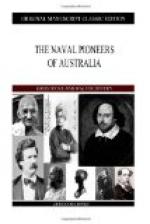The British Fleet, by Commander C.N. Robinson, is an invaluable book to the student of naval history, and, notwithstanding plenty of book authorities and ten years’ study of the subject, the present writers are compelled to draw upon Commander Robinson for many details. With the aid of this work and from allusions to be found in the writings of a couple of centuries ago, it is possible to make some sort of picture of Dampier’s companions in the Roebuck.
Dampier himself was a type of naval officer who entered the service of the country by what was then, and remained for many years afterwards, one of the best sources of supply. He had been given a fair education, and had been duly apprenticed and learned the profession of a sailor in a merchant ship. Upon his return from his first voyage to the South Seas he published an account of his travels, and dedicated it to the President of the Royal Society, the Hon. Charles Mountague, who, appreciating the author’s zeal and his intelligent public spirit, recommended him to the patronage of the Earl of Oxford, then Principal Lord of the Admiralty. Dampier’s dedication has nothing of the fulsome flattery and begging-letter style so often the chief characteristic of such compositions, but is the straightforward offer of a humble worker in science of the best of his work to the man best able to appreciate and to make the most of it. Dampier’s dedication led to his appointment in the navy, and the transaction does honour to both the patron and him who was patronized.
As is well known, until comparatively recent times only the officers of the fighting branch held commissions; all others were either warrant or petty officers. In the time of William III., a captain and one lieutenant were allowed to each ship, and none of the other officers held commissions. The peaceful mission of the Roebuck justifies us in concluding that Dampier held the King’s commission as a lieutenant commanding, and he was probably given a lieutenant to take charge in case of accident, a master, a couple of master’s mates, a gunner, a boatswain and carpenter, and the usual petty officers; seamen and boys made up the complement. Dampier’s pay, so far as we can ascertain, would be at the rate of about L12 per month.
Two regiments of marine infantry had been formed so early as 1689, but they were disbanded nine years later. It was not until 1703 that the marines, all infantry, became a permanent branch of the service.
Uniforms had not even been thought of at this time, and the Roebuck’s officers, from her commander downwards, ate and drank and clothed themselves in much the same fashion as their men. Dampier probably had a room right aft under the long poop, and the other officers at the same end of the ship in canvas-partitioned cabins, the fore part of her one living deck being occupied by the crew. There was probably a mess-room under the poop common to all the officers. What they had to eat and drink, as we have said, was the same for all ranks. Here is a scale of provisions for eighty-five men of a sixth-rate of 1688 for two months, taken from Charnock:—




